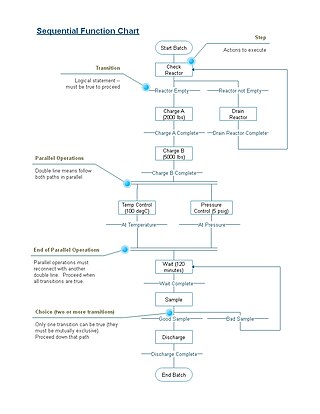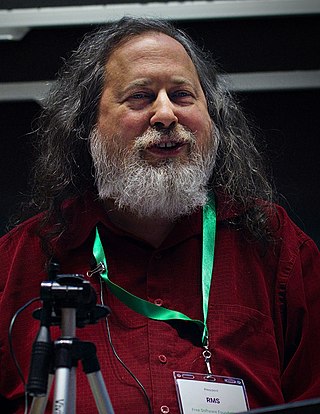Related Research Articles

A computer program is a sequence or set of instructions in a programming language for a computer to execute. It is one component of software, which also includes documentation and other intangible components.

Free software, libre software, or libreware is computer software distributed under terms that allow users to run the software for any purpose as well as to study, change, and distribute it and any adapted versions. Free software is a matter of liberty, not price; all users are legally free to do what they want with their copies of a free software regardless of how much is paid to obtain the program. Computer programs are deemed "free" if they give end-users ultimate control over the software and, subsequently, over their devices.

A field-programmable gate array (FPGA) is a type of integrated circuit that can be programmed or reprogrammed after manufacturing. It consists of an array of programmable logic block and interconnects that can be configured to perform various digital functions. FPGAs are commonly used in applications where flexibility, speed, and parallel processing capabilities are required, such as in telecommunications, automotive, aerospace, and industrial sectors.
The hacker ethic is a philosophy and set of moral values within hacker culture. Practitioners believe that sharing information and data with others is an ethical imperative. The hacker ethic is related to the concept of freedom of information, as well as the political theories of anti-authoritarianism, anarchism, and libertarianism.
A terminate-and-stay-resident program is a computer program running under DOS that uses a system call to return control to DOS as though it has finished, but remains in computer memory so it can be reactivated later. This technique partially overcame DOS's limitation of executing only one program, or task, at a time. TSRs are used only in DOS, not in Windows.
The hacker culture is a subculture of individuals who enjoy—often in collective effort—the intellectual challenge of creatively overcoming the limitations of software systems or electronic hardware, to achieve novel and clever outcomes. The act of engaging in activities in a spirit of playfulness and exploration is termed hacking. However, the defining characteristic of a hacker is not the activities performed themselves, but how it is done and whether it is exciting and meaningful. Activities of playful cleverness can be said to have "hack value" and therefore the term "hacks" came about, with early examples including pranks at MIT done by students to demonstrate their technical aptitude and cleverness. The hacker culture originally emerged in academia in the 1960s around the Massachusetts Institute of Technology (MIT)'s Tech Model Railroad Club (TMRC) and MIT Artificial Intelligence Laboratory. Hacking originally involved entering restricted areas in a clever way without causing any major damage. Some famous hacks at the Massachusetts Institute of Technology were placing of a campus police cruiser on the roof of the Great Dome and converting the Great Dome into R2-D2.
Programming paradigms are a way to classify programming languages based on their features. Languages can be classified into multiple paradigms.

The GNU Project is a free software, mass collaboration project announced by Richard Stallman on September 27, 1983. Its goal is to give computer users freedom and control in their use of their computers and computing devices by collaboratively developing and publishing software that gives everyone the rights to freely run the software, copy and distribute it, study it, and modify it. GNU software grants these rights in its license.

A race condition or race hazard is the condition of an electronics, software, or other system where the system's substantive behavior is dependent on the sequence or timing of other uncontrollable events. It becomes a bug when one or more of the possible behaviors is undesirable.
A logic bomb is a piece of code intentionally inserted into a software system that will set off a malicious function when specified conditions are met. For example, a programmer may hide a piece of code that starts deleting files, should they ever be terminated from the company.
Lisp Machines, Inc. was a company formed in 1979 by Richard Greenblatt of MIT's Artificial Intelligence Laboratory to build Lisp machines. It was based in Cambridge, Massachusetts.

Sequential function chart (SFC) is a visual programming language used for programmable logic controllers (PLCs). It is one of the five languages defined by IEC 61131-3 standard. The SFC standard is defined as Preparation of function charts for control systems, and was based on GRAFCET.
Jerusalem is a logic bomb DOS virus first detected at Hebrew University of Jerusalem, in October 1987. On infection, the Jerusalem virus becomes memory resident, and then infects every executable file run, except for COMMAND.COM. COM files grow by 1,813 bytes when infected by Jerusalem and are not re-infected. Executable files grow by 1,808 to 1,823 bytes each time they are infected, and are then re-infected each time the files are loaded until they are too large to load into memory. Some .EXE files are infected but do not grow because several overlays follow the genuine .EXE file in the same file. Sometimes .EXE files are incorrectly infected, causing the program to fail to run as soon as it is executed.

Richard Matthew Stallman, also known by his initials, rms, is an American free software movement activist and programmer. He campaigns for software to be distributed in such a manner that its users have the freedom to use, study, distribute, and modify that software. Software that ensures these freedoms is termed free software. Stallman launched the GNU Project, founded the Free Software Foundation (FSF) in October 1985, developed the GNU Compiler Collection and GNU Emacs, and wrote all versions of the GNU General Public License.

Snippet is a programming term for a small region of re-usable source code, machine code, or text. Ordinarily, these are formally defined operative units to incorporate into larger programming modules. Snippet management is a feature of some text editors, program source code editors, IDEs, and related software. It allows the user to avoid repetitive typing in the course of routine edit operations.
Scribe is a markup language and word processing system that pioneered the use of descriptive markup. Scribe was revolutionary when it was proposed, because it involved for the first time a clean separation of presentation and content.

The HP 64000 Logic Development System, introduced 17 September 1979, is a tool for developing hardware and software for products based on commercial microprocessors from a variety of manufacturers. The systems assisted software development with assemblers and compilers for Pascal and C, provided hardware for in-circuit emulation of processors and memory, had debugging tools including logic analysis hardware, and a programmable read-only memory (PROM) chip programmer. A wide variety of optional cards and software were available tailored to particular microprocessors. When introduced the HP 64000 had two distinguishing characteristics. First, unlike most microprocessor development systems of the day, such as the Intel Intellec and Motorola EXORciser, it was not dedicated to a particular manufacturer's microprocessors, and second, it was designed such that up to six workstations would be connected via the HP-IB (IEEE-488) instrumentation bus to a common hard drive and printer to form a tightly integrated network.
Emacs, originally named EMACS, is a family of text editors that are characterized by their extensibility. The manual for the most widely used variant, GNU Emacs, describes it as "the extensible, customizable, self-documenting, real-time display editor". Development of the first Emacs began in the mid-1970s, and work on its direct descendant, GNU Emacs, is ongoing; its latest version is 29.1, released July 2023.

The Emergency Rocket Communications System (ERCS) was designed to provide a reliable and survivable emergency communications method for the United States National Command Authority, using a UHF repeater placed atop a Blue Scout rocket or Minuteman II intercontinental ballistic missile. ERCS was deactivated as a communication means when President George H.W. Bush issued a message to stand down SIOP-committed bombers and Minuteman IIs on 27 September 1991. Headquarters SAC was given approval by the Joint Chiefs of Staff to deactivate the 494L payloads beginning 1 October 1992. However, Headquarters SAC believed it was inefficient and unnecessary to support ERCS past fiscal year 1991, and kept the accelerated deactivation schedule.
The following outline is provided as an overview of and topical guide to software development:
References
- ↑ Windows Vista home page
- ↑ PostScript Printer Driver Optimization Case Study Archived 2016-03-05 at the Wayback Machine , Adobe Systems, Technical Note #5042, 31 March 1992. Page 5.
- ↑ Williams, Sam (March 2002). "Free as in Freedom – Richard Stallman's Crusade for Free Software". O'Reilly . Retrieved 2008-09-26.
In 1979, Reid made the decision to sell Scribe to a Pittsburgh-area software company called Unilogic. His graduate-student career ending, Reid says he simply was looking for a way to unload the program on a set of developers that would take pains to keep it from slipping into the public domain. To sweeten the deal, Reid also agreed to insert a set of time-dependent functions- "time bombs" in software-programmer parlance-that deactivated freely copied versions of the program after a 90-day expiration date. To avoid deactivation, users paid the software company, which then issued a code that disabled the internal time-bomb feature.
- ↑ Williams, Sam (March 2002). "Free as in Freedom – Richard Stallman's Crusade for Free Software". O'Reilly . Retrieved 2008-09-26.
For Reid, the deal was a win-win. Scribe didn't fall into the public domain, and Unilogic recouped on its investment. For Stallman, it was a betrayal of the programmer ethos, pure and simple. Instead of honoring the notion of share-and-share alike, Reid had inserted a way for companies to compel programmers to pay for information access.
